“Content is king” has been digital marketers’ mantra for years.
But not all content is created equal.
For some terms, you’re not going to show up at the top of the Google search results with an old piece of content.
For example, here are the top results for ‘best microwaves’:
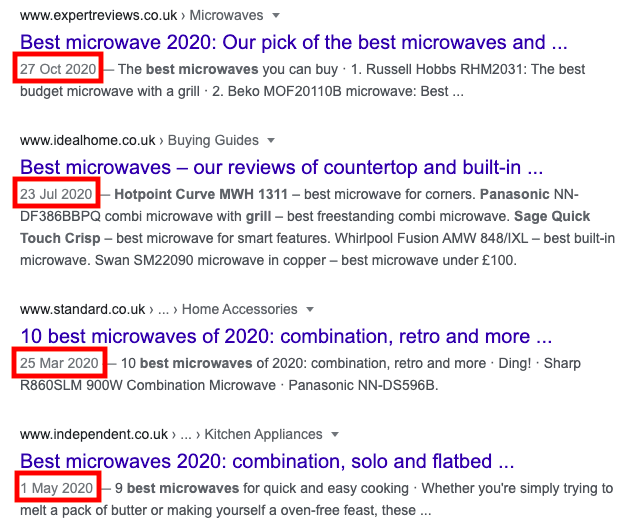
Google is sophisticated enough to understand that if you’re searching ‘best microwaves’ in 2020, you’re not looking for 2016’s best models.
So, as you can see, it surfaces the freshest results to the top of the search results.
But what exactly makes a piece of content fresh in Google’s eyes?
And how do you make sure you’re always reaping the benefits of having fresh content on your site without having an editorial team to write a new blog post every day.
Read on to find out.
What is fresh content?
Fresh content is exactly what it sounds like: brand new text, images, and videos on your site.
This most commonly comes in the form of a new page. You create fresh content whenever you upload a new blog post, add a product to your online store, or create a new service page on your site.
Google will also see existing content that’s undergone a significant change as fresh content (more on how you can leverage that for better rankings in the search results later).
For example, if you rewrite a page on your site it will be considered fresh content.
The metrics Google uses to measure content freshness
Here’s a quick example to illustrate what factors Google looks for when it’s analyzing the freshness of a piece of content: FreshBooks’ recent article on mastering affiliate marketing.
The page’s title tag and headline

Look at the page’s source code and you’ll also see the same applies to the title tag:
These are two key pieces of the puzzle Google looks at when analyzing any page, so putting a signpost to a page’s freshness is a simple and effective strategy.
The publish date
The page’s metadata also reveals it was published on May 7th, 2020:

Together, these two factors tell Google how fresh a page is.
Why fresh content is so important to SEO
A piece of content’s freshness didn’t always impact how well it performed in search.
But a few major algorithm updates – 2010’s Caffeine and 2011’s Freshness – transformed it into a key ranking factor for certain kinds of search terms.
These updates affected the Google results for:
- Recent events or hot topics, like ‘Brexit’ or ‘coronavirus vaccine’.
- Regularly recurring events, like ‘presidential election’ or ‘Super Bowl’.
- Frequent updates, like ‘best tv’, ‘New York rent prices’, or any other search for information that changes often.
Today, if you want to rank at the top of Google for searches that fall into these categories, your content has to be fresh.
How fresh does content have to be for SEO?
How fresh a page has to be to rank depends on whether Google deems that the query deserves freshness (QDF).
Here’s what Google had to say about QDF in 2012:
In short, freshness matters for some searches and doesn’t for others.
If an earthquake had just happened, that query would deserve freshness. Results that aren’t fresh won’t be relevant.
However, the freshness of the results doesn’t impact some queries. Searchers aren’t looking for new information when they search ‘how many inches in a foot’ and ‘when was Shakespeare born’.
Query deserves freshness in action
For example, here’s a snapshot of the first page of Google results for ‘Lionel Messi’:
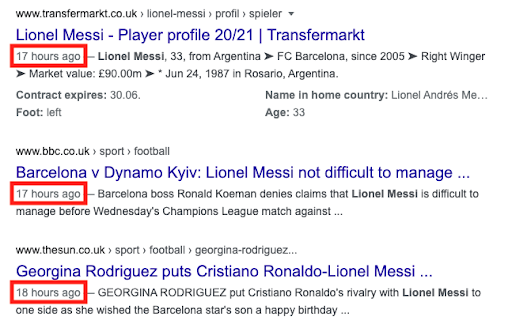
Compared to a search for ‘Napoleon Bonaparte’:
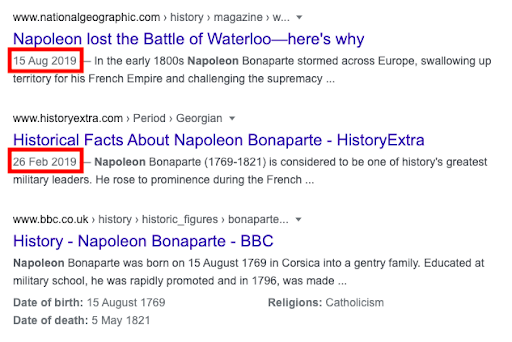
Because Messi is still plying his trade on the soccer pitch, someone searching his name is likely to want up-to-date news about the Barcelona forward – and therefore Google returns results that cover Messi’s current transfer value and recent news stories that involve the player.
If Messi announces his retirement tomorrow, today’s results are no longer going to be relevant to searchers.
Because Napoleon is a historical figure, the pages that Google fetches from its index and returns to users are nowhere near as fresh. What was a relevant result for that search yesterday is also a good result today.
So, if you operate in a niche where there’s a lot of topical, breaking news, then the freshness of your content is essential to your SEO success.
When you’re targeting evergreen terms – ‘how to solve a Rubik’s Cube’, ‘when was the internet invented’, and ‘why is the sky blue’ – freshness takes a backseat in terms of the ranking factors that determine how high up the Google rankings your content will sit.
Why every site can benefit from fresh content
There’s still plenty of reasons to keep your site updated with fresh content by blogging, even if you’re not targeting queries that deserve freshness.
First, the more content you have on your site, the more keywords you’re naturally going to capture.
And the more keywords that are relevant to the niche you’re ranking for, the more authoritative you’ll become in that niche – meaning you’ll find it easier to rank for each individual keyword you target. Understanding and applying topical authority in content creation can further enhance this effect, establishing your site as a go-to resource in your field.
This is why it is important to regularly create fresh content. Even if you are a SaaS business, you still need quality content on your site. You can create new content on your own, or you can work with specialized SaaS marketing agencies. They can help you create unique and SEO-friendly content that ranks high on search engines.
Keep your website updated with fresh content and Google will also respond by regularly crawling and indexing your site, meaning your content is likely to rank faster.
How to consistently create fresh content for your blog
It’s clear that keeping your site updated with fresh content is key to SEO success.
But any business owner or marketer knows this is easier said than done.
Here are a few tips to help you make sure you’re regularly publishing new content and benefiting from the fact Google often prioritizes fresh content in its search results:
Create a content calendar
No one finds themself at the top of Everest without a plan for getting there.
On the same token, you won’t fill your blog with high-quality, search-optimized, and fresh content on a regular basis without a plan for how you’re going to do it.
The first step: follow Backlinko’s step-by-step guide to creating a content calendar so you know exactly what you’re going to create and when.

Without a content calendar in place, you’ve got no chance of keeping your site updated with fresh content.
Refresh your existing content
Content doesn’t need to be completely new to be considered fresh in Google’s eyes.
This means you can get as much value from overhauling your existing content as you can from creating new pages from scratch – as Ahrefs’ guide to doubling your blog traffic in three months without creating any new content illustrates.
For example, you could work some interactive content – such as an interactive calculator or survey – into an old article.
- 87% of marketers using interactive content agree that it grabs the viewer’s attention more effectively than static content.
- Interactive content can generate 2x more conversions and 4-5x more pageviews than passive content.
This makes it a particularly effective way of boosting a piece of content’s freshness, as a page’s engagement signals are a key freshness indicator according to research from Moz:
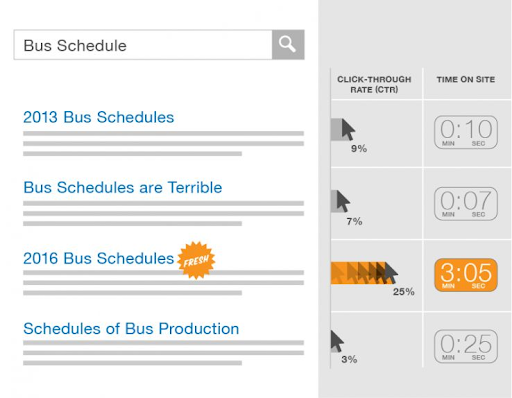
For the best results, follow Venngage’s lead and add something along the lines of ‘[Updated]’ to the page’s title, as it has for its pick of the best annual report design templates:

This will both help send a signal to Google that the content has been refreshed and help improve click-through rates from the Google results pages, as people tend to be drawn to new content.
Don’t focus on quantity over quality
When you’re under pressure to create new content every week, it can be tempting to start cutting corners in order to hit your deadlines.
You might start making the most common content marketing mistakes while scrambling to stick to a self-imposed schedule.
Before you find yourself in that boat, remember that freshness is just one of the hundreds of important Google ranking factors.
Content quality is an important ranking factor – perhaps the most important – so it definitely shouldn’t be overlooked in your quest for freshness.
Not sure if your content is high enough quality?
Use growth marketer Nadya Khoja’s formula for measuring how engaging your content is to check whether each piece of new content is worth publishing or needs more work to be in with a chance of appearing at the top of the Google search results.
How long does it take fresh content to rank in Google?
Unfortunately, there’s no easy answer to the question of how long it will take each piece of fresh content on your site to rank.
It all depends on:
- The overall authority of your site, as well as its authority within the specific niche you operate in.
- How well optimized the page is for search.
- How competitive the keyword you’re targeting with that page is.
Luckily, there are a few things you can do to boost each piece of fresh content’s chances of performing well in search:
First, follow Google’s guidance on submitting a URL for indexing to make sure it’s available to appear in search results as soon as possible.
It’s also crucial that you make sure every piece of content you create is optimized for search. Loganix’s guide to on-page SEO is a great checklist to run through before hitting publish on a fresh piece of content to help ensure it’s fully optimized. Moreover, you should understand the E-E-A-T and YMYL principles. They ensure your content meets the highest standards of expertise, authoritativeness, and trustworthiness.
One thing that is important to keep in mind is that no matter how well optimized your fresh content is, it’s of no use if it’s not targeted around search intent. But with Google constantly changing its algorithm, you need to focus on the top ranking factors that will be important for SEO.
For example, Wall Street Zen outranks extremely authoritative sites like Wikipedia, CNN, and Investopedia for the term “stock predictions”:
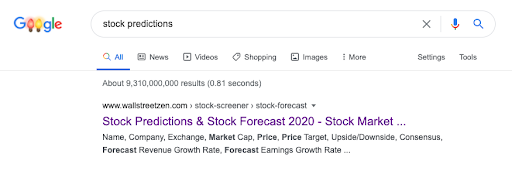
And it achieves this by providing searchers exactly what they’re looking for when they search this term – a table – rather than its more authoritative competitors, who have all written articles:
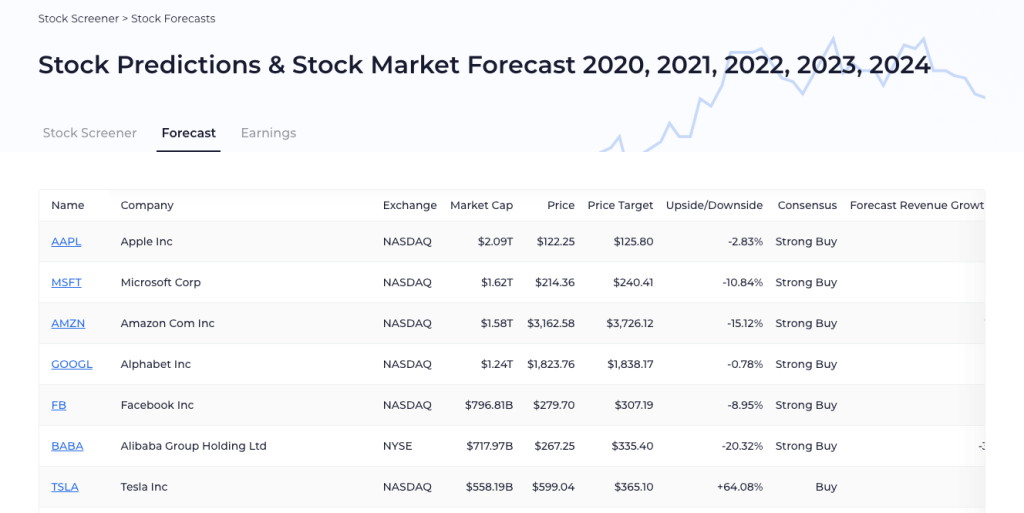
Meet searcher intent with your fresh content for the best chances of ranking with it.
You should also make sure to add internal links from established pages on your site to the new page, which will pass link equity to the new page and help bolster its chances of ranking in Google.
Lastly, for the best results, you should run a link building campaign to generate backlinks from relevant and authoritative sites back to your fresh piece of content. You’ll have the best chances with this if your content is a linkable asset, which you can achieve by using surveys to improve your SEO and content strategy.
Summary
Hopefully, now you understand the importance of investing in fresh content for your site – especially if you operate in a niche that has plenty of breaking news or ever-changing information.
Of course, any business can benefit from fresh content by regularly producing high-quality articles and guides and refreshing existing pages following the advice laid out in this guide.
This will give your content the best possible chances of ranking at the top of the Google search results for its target keywords.


